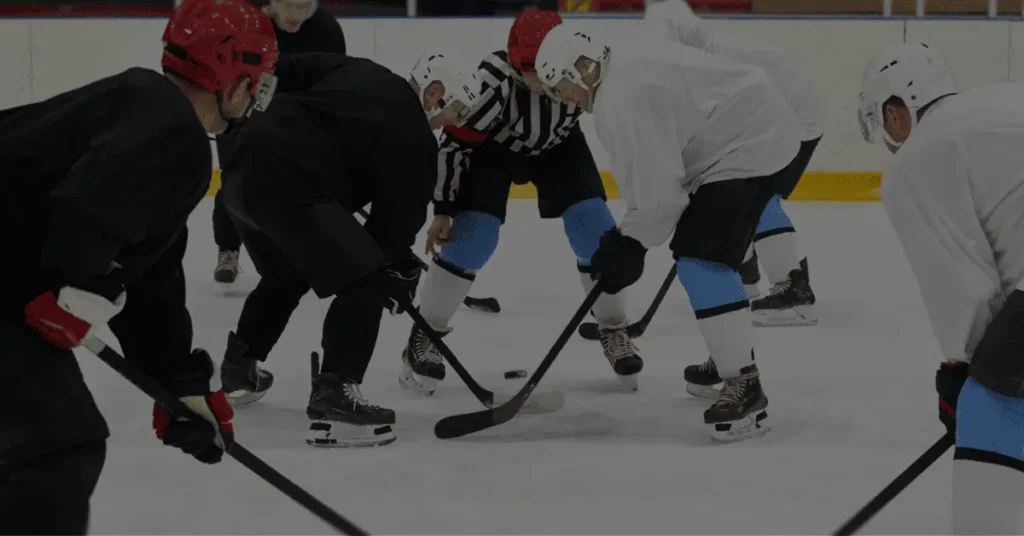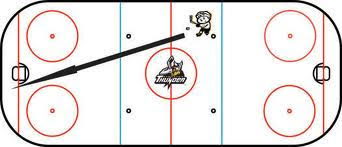The first rule that new ice hockey players or supporters need to grasp and understand is the offside hockey rule. Without it, the game is meaningless and oftentimes appears to be boxing on ice.
Newcomers to ice hockey may wonder why there are so many distinct colored lines marking the rink. These are employed to create separate attacking and defensive zones, as well as a neutral area, on the playing field. The blue lines are a major factor for the on-ice referees when determining whether a play is onside or offside.
What is hockey’s offside rule?
In hockey, offside occurs when an attacking player who is already in the offensive zone but does not have possession of the puck is assisted by another attacking player in getting the puck into the offensive zone. This decision is final until the attacking players all leave the offensive zone or the puck leaves the zone.
To put it another way, after players have entered the offensive zone, the attacking side must stop allowing the puck to cross over. An attacking player must immediately retreat to the neutral zone or be called for offside if they enter the offensive zone before the puck.
To determine if a player is onside, it is important to consider where the puck is and where the players are positioned in the attacking and neutral zones. The puck’s status is often determined by whether it completely crosses the blue line when it enters or exits the attacking zone.
If at least one skater is in the neutral zone or touches the imaginary plane rising from the front edge of the blue line, the player stays in the neutral zone; if not, they are in the offensive zone.
Which three hockey zones are there?
Hockey’s three zones are the attacking, defending, and neutral zones. They are divided by two blue lines that run parallel to each other across the ice. The attacking and defending zones are both 75 feet long, while the neutral zone is 50 feet long. The rink could have an 85-foot width.
Protective Zone
Now, let’s discuss the defense zone. On the precise spot where they guard against the opposition’s attempts to score, each team’s goal stands tall and proud here. In this zone, there are two faceoff circles: one on the left and one on the right, just in front of the goalie.
Zone of Neutrality
We are currently in the neutral zone. Those two blue horizontal lines divide this area of the hockey arena, which is its midsection. With one faceoff circle, this is frequently referred to as the center of the rink. This area usually serves as the faceoff stage for icing calls, faceoffs to start each period, and faceoffs to start the game.
Zone of Attack
The offensive zone, often known as the attacking zone, comes next. This is the arena where the team in possession of the puck goes on the attack, attempting to get past the goalie of the opposition. It features two faceoff circles that are prepared for action, just like the defensive zone.
In hockey, what is the blue line?
Now, let’s discuss the hockey “Blue Line.” This crucial barrier, which is more than just a standard ice stripe, divides the offensive, neutral, and defensive zones. It does, however, have a more significant role as the offside line of truth.
If a player from the attacking team enters the attacking zone before the puck and makes contact with it, the referee will not permit it. When the special whistle bursts, indicating an offside offense, the play is paused. Think of the Blue Line as a vigilant guard, ensuring that everyone abides by the regulations and stays in their designated spots on the ice.
Which three kinds of offside hockey exist?
There are three distinct offsides in ice hockey, and each has a distinct outcome. Offside deflections, deliberate offsides, and delayed offsides are the three types.
Let’s discuss a few intriguing offside hockey scenarios:
Postponed Offsides
It’s a difficult move in the game. This happens when a player on the attacking team enters the offensive zone before the puck has been touched. In most leagues, they get another chance. They call this process “tagging up.” Before retrying to get the puck, the entire assaulting team may skate back outside the offensive zone.
After all players have departed the attacking zone, those delayed offsides are meaningless. To be deemed in the offensive zone, the puck must be touched by an attacking player both during the tagging up and during the puck’s presence in the zone.
Willful Offsides
This is entirely reminiscent of a cunning trick. It is signaled when the referee feels that the attacking team is trying to cause an offside intentionally. Imagine the following play: the puck is sent into the offensive zone by the player in possession of it, and while they are still in the zone, one of their teammates touches it.
How do they accomplish that? Well, it’s usually a sneaky move on their part to let their tired players change out without having to leave the rink.
Deflections of Offsides
This is not the usual surprise. Imagine a situation when the opposing team tries to clear the puck, but it hits a referee in the neutral zone and then rebounds back into their defensive zone. It might still be off-balance. It is fair play and the attacking team may proceed if the puck leaves the zone, strikes a defender, and then comes back to their side. It seems like a pleasant addition has been made to the game!
When was the offside hockey regulation changed by the NHL?
In 2020–21, the offside hockey rule was somewhat changed to allow players to remain in the attacking zone even if their skate was in the air and hovering over the blue line when the puck passed it.
When a player’s skates touch the blue line, they are considered to be onside. The puck is considered to be on their side of the line when it fully crosses the blue line’s leading edge.
A “plane” of the blue line that rises from the leading edge will define the area on his side of the line. For the purposes of the off-side rule, a player is deemed to be on-side if their skate does not yet breach the “plane” before the puck touches the leading edge.
Why does hockey’s offside rule matter?
The offside rule was created to stop teams from “goal hanging,” which is when offensive players remain close to their opponent’s goal when the puck is in their own defensive zone or neutral zone.
Under the offside hockey regulation, players are not allowed to chase the puck until it has completely entered the zone.

When a player is offside, what happens?
Play will stop when an attacking player is judged to be offside, and the linesman will sound the whistle. The action will continue to give the opposing team an unhindered chance to clear or carry the puck out of its end if a delayed offside is found.
The linesman will sound the whistle if an offensive player makes touch with the other team while it has the puck in its zone, as delayed offside is now considered offside.
Following an offside whistle in hockey, what happens?
Going Over the Blue Line
If an attacker brings the puck over the line and the play is deemed offside, the ensuing faceoff will occur outside the blue line, specifically inside the neutral zone. The exact location of the faceoff will be the one nearest to the puck carrier’s position at the time of the infraction.
Hockey offside brought on by shots or passes
If an attacker throws the puck into the opposition zone or makes a faulty pass that results in an offside hockey penalty, the faceoff will take place in the zone where the shot or pass happened.
Distinguishing Between Intentional and Delayed Offsides
The faceoff will still take place at the closest dot in the neutral zone in the event of a delayed offside. On the other hand, if there is a deliberate offside, the faceoff is repositioned back into the attacking team’s zone.
Was there an offside rule in hockey from the beginning of the game?
A restriction that prohibited making forward passes was in place when ice hockey first started. Players were forced to skate the puck up the rink in its place. When forward passes were permitted in the neutral zone in 1918–1919 and later extended to the defensive and neutral zones in 1927, things began to alter.
The Introduction of Passes for Every Zone
Then, in 1929, they took a significant step. It was said that forward passes could be made in each of the three ice surface zones. The games were more thrilling as a result of this modification, and more goals were scored.
Making Use of the Last Freedom
Players could receive passes from their teammates from wherever on the ice at the same time. Imagine receiving a pass from your defensive zone when you’re close to the opponent’s goal—that pass was suddenly permitted.
What is 2 line pass in Hockey?
However, there was an issue. It wasn’t fair that certain players would hang around close to the opposition’s goal. Thus, the NHL implemented the offside rule in 1929. Teams were forced to carry the puck over both the offensive and defensive blue lines going forward.
The Center-Ice Red Line’s Function
The center-ice red line did not exist in the NHL until 1943–1944. Players could pass the puck to teammates on their side of the red line from their defensive zone when it was first implemented. However, the center-ice red line for offside purposes was eliminated in 2005.
Recognizing the Two-Line Pass Regulation
What then was the purpose of the two-line pass rule? It was a rule when the center-ice line was still used in the game. It meant that throughout the action, you could not pass a ball over two lines to a teammate.
Is the Rule Still in Effect?
It’s the newest information: When they ceased using the center-ice line for offside purposes in 2005, they eliminated the two-line pass regulation. The ability for players to legally pass the puck from anywhere in their defensive zone to the opponent’s blue line has increased the excitement level of hockey games nowadays.
What are the NHL’s current offside hockey regulations?
The NHL has been using contemporary offside hockey rules for several years now. The center-ice red line for offside passes was eliminated by the NHL in 2005, and during the 2020–21 season, the offside regulations underwent yet another modification.
Difficulties in a Quick-Firing Game
The problem is that ice hockey moves quickly, making it extremely difficult for NHL linesmen to call every offside hockey regulation correctly. Consider this: coaches appeal frequently during the season due to missed offside calls that result in goals. And what do you know? The majority of these attempts are successful.
The Unnoticed Lost Calls
This provides us with crucial information. We only become aware of the offside hockey rule calls that linesmen may be missing throughout a game when a coach’s challenge is applied. The offside hockey regulations may alter as a result of this revelation. Therefore, it shouldn’t come as a surprise if technology is used in the future to assist linesmen in calling offside hockey rules as accurately as possible.
Copying Techniques from Other Sports
How might the technology be designed? Perhaps it’s similar to the technology used in soccer goal lines or tennis nets to determine if a ball is in or out. To ensure that offside hockey rule calls are precise and fair, hockey may take some cues from these other sports.


